ASUS ROG Crosshair VIII Hero Service Manual

ROG CROSSHAIR |
Motherboard |
|
|
VIII HERO |
|
(WI-FI) |
|
|
|

E15378
First Edition
May 2019
Copyright © 2019 ASUSTeK COMPUTER INC. All Rights Reserved.
No part of this manual, including the products and software described in it, may be reproduced, transmitted, transcribed, stored in a retrieval system, or translated into any language in any form or by any means, except documentation kept by the purchaser for backup purposes, without the express written permission of ASUSTeK COMPUTER INC. (“ASUS”).
Product warranty or service will not be extended if: (1) the product is repaired, modified or altered, unless such repair, modification of alteration is authorized in writing by ASUS; or (2) the serial number of the product is defaced or missing.
ASUS PROVIDES THIS MANUAL “AS IS” WITHOUT WARRANTY OF ANY KIND, EITHER EXPRESS OR IMPLIED, INCLUDING BUT NOT LIMITED TO THE IMPLIED WARRANTIES OR CONDITIONS OF MERCHANTABILITY OR FITNESS FOR A PARTICULAR PURPOSE. IN NO EVENT SHALL ASUS, ITS DIRECTORS, OFFICERS, EMPLOYEES OR AGENTS BE LIABLE FOR ANY INDIRECT, SPECIAL, INCIDENTAL, OR CONSEQUENTIAL DAMAGES (INCLUDING DAMAGES FOR LOSS OF PROFITS, LOSS OF BUSINESS, LOSS OF USE OR DATA, INTERRUPTION OF BUSINESS AND THE LIKE), EVEN IF ASUS HAS BEEN ADVISED OF THE POSSIBILITY OF SUCH DAMAGES ARISING FROM ANY DEFECT OR ERROR IN THIS MANUAL OR PRODUCT.
SPECIFICATIONS AND INFORMATION CONTAINED IN THIS MANUAL ARE FURNISHED FOR INFORMATIONAL USE ONLY, AND ARE SUBJECT TO CHANGE AT ANY TIME WITHOUT NOTICE, AND SHOULD NOT BE CONSTRUED AS A COMMITMENT BY ASUS. ASUS ASSUMES NO RESPONSIBILITY OR LIABILITY FOR ANY ERRORS OR INACCURACIES THAT MAY APPEAR IN THIS MANUAL, INCLUDING THE PRODUCTS AND SOFTWARE DESCRIBED IN IT.
Products and corporate names appearing in this manual may or may not be registered trademarks or copyrights of their respective companies, and are used only for identification or explanation and to the owners’ benefit, without intent to infringe.
Offer to Provide Source Code of Certain Software
This product contains copyrighted software that is licensed under the General Public License (“GPL”), under the Lesser General Public License Version (“LGPL”) and/or other Free Open Source Software Licenses. Such software in this product is distributed without any warranty to the extent permitted by the applicable law. Copies of these licenses are included in this product.
Where the applicable license entitles you to the source code of such software and/or other additional data, you may obtain it for a period of three years after our last shipment of the product, either
(1)for free by downloading it from https://www.asus.com/support/
or
(2)for the cost of reproduction and shipment, which is dependent on the preferred carrier and the location where you want to have it shipped to, by sending a request to:
ASUSTeK Computer Inc.
Legal Compliance Dept.
15 Li Te Rd.,
Beitou, Taipei 112
Taiwan
In your request please provide the name, model number and version, as stated in the About Box of the product for which you wish to obtain the corresponding source code and your contact details so that we can coordinate the terms and cost of shipment with you.
The source code will be distributed WITHOUT ANY WARRANTY and licensed under the same license as the corresponding binary/object code.
This offer is valid to anyone in receipt of this information.
ASUSTeK is eager to duly provide complete source code as required under various Free Open Source Software licenses. If however you encounter any problems in obtaining the full corresponding source code we would be much obliged if you give us a notification to the email address gpl@asus.com, stating the product and describing the problem (please DO NOT send large attachments such as source code archives, etc. to this email address).
ii

Contents
Safety information...................................................................................................... |
vi |
About this guide......................................................................................................... |
vii |
ROG CROSSHAIR VIII HERO (WI-FI) specifications summary............................... |
ix |
Package contents...................................................................................................... |
xv |
Installation tools and components.......................................................................... |
xvi |
Chapter 1: |
Product Introduction |
|
|
1.1 |
Motherboard overview............................................................................... |
1-1 |
|
|
1.1.1 |
Before you proceed..................................................................... |
1-1 |
|
1.1.2 |
Motherboard layout...................................................................... |
1-2 |
|
1.1.3 |
Central Processing Unit (CPU).................................................... |
1-4 |
|
1.1.4 |
System memory........................................................................... |
1-5 |
|
1.1.5 |
Expansion slots............................................................................ |
1-7 |
|
1.1.6 |
Onboard buttons.......................................................................... |
1-9 |
|
1.1.7 |
Onboard switches...................................................................... |
1-11 |
|
1.1.8 |
Onboard jumpers....................................................................... |
1-12 |
|
1.1.9 |
Onboard LEDs........................................................................... |
1-13 |
|
1.1.10 |
Internal connectors.................................................................... |
1-16 |
1.2 |
ProbeIt |
....................................................................................................... |
1-29 |
Chapter 2: |
Basic Installation |
|
|
2.1 |
Building your PC system........................................................................... |
2-1 |
|
|
2.1.1 |
CPU installation........................................................................... |
2-1 |
|
2.1.2 |
Cooling system installation.......................................................... |
2-2 |
|
2.1.3 |
Motherboard installation.............................................................. |
2-5 |
|
2.1.4 |
DIMM installation......................................................................... |
2-7 |
|
2.1.5 |
ATX power connection................................................................. |
2-8 |
|
2.1.6 |
SATA device connection.............................................................. |
2-9 |
|
2.1.7 |
Front I/O connector.................................................................... |
2-10 |
|
2.1.8 |
Expansion card installation........................................................ |
2-11 |
|
2.1.9 |
M.2 installation........................................................................... |
2-12 |
|
2.1.10 |
Wi-Fi antenna installation.......................................................... |
2-14 |
2.2 |
BIOS update utility.................................................................................... |
2-15 |
|
2.3 |
Motherboard rear and audio connections.............................................. |
2-16 |
|
|
2.3.1 |
Rear I/O connection................................................................... |
2-16 |
|
2.3.2 |
Audio I/O connections................................................................ |
2-18 |
2.4 |
Starting up for the first time.................................................................... |
2-20 |
|
2.5 |
Turning off the computer......................................................................... |
2-20 |
|
iii

Chapter 3: |
BIOS Setup |
|
|
3.1 |
Knowing BIOS............................................................................................. |
3-1 |
|
3.2 |
BIOS setup program................................................................................... |
3-2 |
|
|
3.2.1 |
Advanced Mode........................................................................... |
3-3 |
|
3.2.2 |
EZ Mode...................................................................................... |
3-6 |
|
3.2.3 |
Q-Fan Control.............................................................................. |
3-7 |
|
3.2.4 |
EZ Tuning Wizard........................................................................ |
3-9 |
3.3 |
My Favorites.............................................................................................. |
3-11 |
|
3.4 |
Main menu................................................................................................. |
3-13 |
|
3.5 |
Extreme Tweaker menu............................................................................ |
3-13 |
|
3.6 |
Advanced menu........................................................................................ |
3-14 |
|
|
3.6.1 |
AMD fTPM configuration............................................................ |
3-14 |
|
3.6.2 |
CPU Configuration..................................................................... |
3-15 |
|
3.6.3 |
SATA Configuration................................................................... |
3-15 |
|
3.6.4 |
Onboard Devices Configuration................................................. |
3-16 |
|
3.6.5 |
APM Configuration..................................................................... |
3-18 |
|
3.6.6 |
PCI Subsystem Settings............................................................ |
3-18 |
|
3.6.7 |
USB Configuration..................................................................... |
3-19 |
|
3.6.8 |
HDD/SSD SMART Information.................................................. |
3-19 |
|
3.6.9 |
Network Stack Configuration..................................................... |
3-19 |
|
3.6.10 |
AMD CBS ................................................................................. |
3-20 |
|
3.6.11 |
AMD PBS .................................................................................. |
3-20 |
3.7 |
Monitor menu............................................................................................ |
3-20 |
|
3.8 |
Boot menu................................................................................................. |
3-21 |
|
3.9 |
Tool menu.................................................................................................. |
3-22 |
|
|
3.9.1 |
ASUS EZ Flash 3 Utility............................................................. |
3-22 |
|
3.9.2 |
ASUS Secure Erase.................................................................. |
3-23 |
|
3.9.3 |
ASUS User Profile..................................................................... |
3-24 |
|
3.9.4 |
ASUS SPD Information.............................................................. |
3-24 |
|
3.9.5 |
Graphics Card Information......................................................... |
3-24 |
|
3.9.6 |
ASUS Armoury Crate................................................................. |
3-25 |
3.10 |
Exit menu................................................................................................... |
3-25 |
|
3.11 |
Updating BIOS.......................................................................................... |
3-26 |
|
|
3.11.1 |
EZ Update.................................................................................. |
3-26 |
|
3.11.2 ASUS EZ Flash 3....................................................................... |
3-27 |
|
|
3.11.3 ASUS CrashFree BIOS 3.......................................................... |
3-29 |
|
iv

Chapter 4: |
RAID Support |
|
|
4.1 |
AMD RAID Array configurations |
...............................................................4-1 |
|
|
4.1.1 |
RAID definitions ........................................................................... |
4-1 |
Appendix |
|
|
|
Q-Code table |
............................................................................................................. |
A-1 |
|
Notices |
..................................................................................................................... |
|
A-5 |
ASUS contact ....................................................................................information |
A-11 |
||
v

Safety information
Electrical safety
•To prevent electrical shock hazard, disconnect the power cable from the electrical outlet before relocating the system.
•When adding or removing devices to or from the system, ensure that the power cables for the devices are unplugged before the signal cables are connected. If possible, disconnect all power cables from the existing system before you add a device.
•Before connecting or removing signal cables from the motherboard, ensure that all power cables are unplugged.
•Seek professional assistance before using an adapter or extension cord. These devices could interrupt the grounding circuit.
•Ensure that your power supply is set to the correct voltage in your area. If you are not sure about the voltage of the electrical outlet you are using, contact your local power company.
•If the power supply is broken, do not try to fix it by yourself. Contact a qualified service technician or your retailer.
Operation safety
•Before installing the motherboard and adding devices on it, carefully read all the manuals that came with the package.
•Before using the product, ensure all cables are correctly connected and the power cables are not damaged. If you detect any damage, contact your dealer immediately.
•To avoid short circuits, keep paper clips, screws, and staples away from connectors, slots, sockets and circuitry.
•Avoid dust, humidity, and temperature extremes. Do not place the product in any area where it may become wet.
•Place the product on a stable surface.
•If you encounter technical problems with the product, contact a qualified service technician or your retailer.
vi

About this guide
This user guide contains the information you need when installing and configuring the motherboard.
How this guide is organized
This guide contains the following parts:
•Chapter 1: Product Introduction
This chapter describes the features of the motherboard and the new technology it supports. It includes description of the switches, jumpers, and connectors on the motherboard.
•Chapter 2: Basic Installation
This chapter lists the hardware setup procedures that you have to perform when installing system components.
•Chapter 3: BIOS Setup
This chapter tells how to change system settings through the BIOS Setup menus. Detailed descriptions of the BIOS parameters are also provided.
•Chapter 4: RAID Support
This chapter describes the RAID configurations.
Where to find more information
Refer to the following sources for additional information and for product and software updates.
1.ASUS website
The ASUS website (www.asus.com) provides updated information on ASUS hardware and software products.
2.Optional documentation
Your product package may include optional documentation, such as warranty flyers, that may have been added by your dealer. These documents are not part of the standard package.
vii

Conventions used in this guide
To ensure that you perform certain tasks properly, take note of the following symbols used throughout this manual.
DANGER/WARNING: Information to prevent injury to yourself when trying to complete a task.
CAUTION: Information to prevent damage to the components when trying to complete a task.
IMPORTANT: Instructions that you MUST follow to complete a task.
NOTE: Tips and additional information to help you complete a task.
Typography
Bold text |
Indicates a menu or an item to select. |
Italics |
Used to emphasize a word or a phrase. |
<Key> |
Keys enclosed in the less-than and greater-than sign |
|
means that you must press the enclosed key. |
|
Example: <Enter> means that you must press the Enter |
|
or Return key. |
<Key1> + <Key2> + <Key3> |
If you must press two or more keys simultaneously, the |
|
key names are linked with a plus sign (+). |
viii

ROG CROSSHAIR VIII HERO (WI-FI) specifications summary
|
AMD AM4 Socket for 3rd and 2nd Gen AMD Ryzen™/ 2nd and 1st |
|
CPU |
Gen AMD Ryzen™ with Radeon™ Vega Graphics Processors* |
|
|
* Refer to www.asus.com for the AMD CPU support list. |
|
|
|
|
Chipset |
AMD X570 |
|
|
|
|
|
3rd Gen AMD Ryzen™ Processors |
|
|
4 x DIMM, max. 128GB, DDR4 4600+(O.C.) / 4533(O.C.) / |
|
|
4400(O.C.) / 4266(O.C.) / 4133(O.C.) / 4000(O.C.) / 3866(O.C.) / |
|
|
3733(O.C.) / 3600(O.C.) / 3466(O.C.) / 3200(O.C.) / 3000(O.C.) |
|
|
/ 2933(O.C.) / 2800(O.C.) / 2666 / 2400 / 2133 MHz non-ECC, |
|
|
un-buffered memory |
|
|
2nd Gen AMD Ryzen™ Processors |
|
|
4 x DIMM, max. 64GB, DDR4 3600(O.C.) / 3466(O.C.) / |
|
Memory |
3200(O.C.) / 3000(O.C.) / 2933(O.C.) / 2800(O.C) / 2666 / 2400 / |
|
|
2133 MHz non-ECC, un-buffered memory |
|
|
2nd and 1st Gen AMD Ryzen™ with Radeon™ Vega Graphics |
|
|
Processors |
|
|
4 x DIMM, max. 64GB, DDR4 3200(O.C.) / 3000(O.C.) / |
|
|
2933(O.C.) / 2800(O.C) / 2666 / 2400 / 2133 MHz non-ECC, un- |
|
|
buffered memory |
|
|
Dual channel memory architecture |
|
|
* Refer to www.asus.com for the Memory QVL (Qualified Vendors List). |
|
|
|
|
|
3rd Gen AMD Ryzen™ Processors |
|
|
- 2 x PCIe 4.0 x16 SafeSlots (supports x16, x8/x8) |
|
|
2nd Gen AMD Ryzen™ Processors |
|
|
- 2 x PCIe 3.0 x16 SafeSlots (supports x16, x8/x8) |
|
Expansion slots |
2nd and 1st Gen AMD Ryzen™ with Radeon™ Vega Graphics |
|
Processors |
||
|
||
|
- 1 x PCIe 3.0 x16 SafeSlot (supports x8) |
|
|
AMD X570 chipset |
|
|
- 1 x PCIe 4.0 x16 (supports x4) |
|
|
- 1 x PCIe 4.0 x1 |
|
|
|
|
|
3rd and 2nd Gen AMD Ryzen™ Processors |
|
|
Supports NVIDIA® 2-Way SLI® Technology |
|
Multi-GPU |
Supports AMD 3-Way CrossFireX™ Technology |
|
2nd and 1st Gen AMD Ryzen™ with Radeon™ Vega Graphics |
||
|
||
|
Processors |
|
|
Supports AMD 2-Way CrossFireX™ Technology |
|
|
(continued on the next page) |
ix

ROG CROSSHAIR VIII HERO (WI-FI) specifications summary
|
3rd Gen AMD Ryzen™ Processors |
|
|
- 1 x M.2 Socket 3 with M Key, type 2242 / 2260 / 2280 |
|
|
(PCIE 4.0 x4 and SATA modes) storage devices support |
|
|
2nd Gen AMD Ryzen™ / 2nd and 1st Gen AMD Ryzen™ with |
|
|
Radeon™ Vega Graphics Processors |
|
Storage |
- 1 x M.2 Socket 3 with M Key, type 2242 / 2260 / 2280 |
|
(PCIE 3.0 x4 and SATA modes) storage devices support |
||
|
||
|
AMD X570 chipset |
|
|
- 8 x SATA 6Gb / s ports |
|
|
- Support Raid 0, 1, 10 |
|
|
- 1 x M.2 Socket 3 with M Key, type 2242 / 2260 / 2280 / 22110 |
|
|
(PCIE 4.0 x4 and SATA modes) storage devices support |
|
|
|
|
|
Realtek RTL8125-CG 2.5G LAN |
|
LAN |
Intel® Ethernet Controller I211-AT |
|
Anti-surge LANGuard |
||
|
||
|
ROG GameFirst Technology |
|
|
|
|
|
Intel® Wi-Fi 6 AX200 |
|
|
2 x 2 Wi-Fi 6 (802.11 a/b/g/n/ac/ax) with MU-MIMO supports dual |
|
Wireless Data Network |
frequency band 2.4/5GHz |
|
|
Supports channel bandwidth: HT20/HT40/HT80/HT160 |
|
|
Up to 2.4Gbps transfer speed |
|
|
|
|
Bluetooth |
Bluetooth v5.0 |
|
|
|
|
|
ROG SupremeFX 8-Channel High Definition Audio CODEC |
|
|
S1220 |
|
|
- Supports up to 32-Bit/192kHz playback* |
|
|
- High quality 120 dB SNR stereo playback output and 113 dB |
|
|
SNR recording input |
|
|
- Impedance sense for front and rear headphone outputs |
|
|
- ESS® ES9023P High Definition DAC |
|
Audio |
- SupremeFX Shielding Technology |
|
|
- Jack-detection, Multi-streaming, and Front Panel Jack-retasking |
|
|
- Optical S/PDIF out port at back Panel |
|
|
Audio Features: |
|
|
- Sonic Radar III |
|
|
- Sonic Studio III + Sonic Studio Virtual Mixer |
|
|
* Due to limitations in HDA bandwidth, 32-Bit/192kHz is not supported |
|
|
for 8-Channel audio. |
|
|
(continued on the next page) |
x

ROG CROSSHAIR VIII HERO (WI-FI) specifications summary
|
3rd Gen AMD Ryzen™ Processors |
|
|
- 4 x USB 3.2 Gen 2 ports (4 ports at back panel, Type-A [red]) |
|
|
2nd Gen AMD Ryzen™ / 2nd and 1st Gen AMD Ryzen™ with |
|
|
Radeon™ Vega Graphics Processors |
|
|
- 4 x USB 3.2 Gen 1 ports (4 ports at back panel, Type-A [red]) |
|
USB |
AMD X570 chipset |
|
- 1 x USB 3.2 Gen 2 front panel connector |
||
|
||
|
- 4 x USB 3.2 Gen 2 ports (4 ports at back panel, 3 x Type-A [red], |
|
|
1 x Type-C) |
|
|
- 6 x USB 3.2 Gen 1 ports (4 ports at back panel [blue], 2 ports at |
|
|
front panel) |
|
|
- 4 x USB 2.0 ports at front panel |
|
|
|
|
|
Extreme Engine Digi+ |
|
|
- MicroFine Alloy Choke |
|
|
- 10K Black Metallic Capacitors |
|
|
- IR3555 PoweIRstage® |
|
|
ROG Extreme OC kit: |
|
|
- Safe Boot button |
|
|
- Slow Mode |
|
|
- LN2 Mode |
|
ROG Exclusive Features |
- OptiMem III |
|
|
Extreme Tweaker |
|
|
ROG Exclusive Software |
|
|
- RAMCache III |
|
|
- ROG RAMDisk |
|
|
- CPU-Z |
|
|
- GameFirst V |
|
|
- Sonic Studio III + Sonic Studio Virtual Mixer |
|
|
- Sonic Radar III |
|
|
(continued on the next page) |
xi

ROG CROSSHAIR VIII HERO (WI-FI) specifications summary
ASUS Exclusive Software Features
- Armoury Crate - AURA
- ASUS Dual Intelligent Processors 5
- 5-way Optimization tuning key perfectly consolidates TPU
Insights, EPU Guidance, DIGI+ VRM, Fan Expert 4, and Turbo app
- AI Suite 3
- ASUS EZ DIY
- ASUS CrashFree BIOS 3 - ASUS EZ Flash 3
- ASUS C.P.R. (CPU Parameter Recall) - Ai Charger
Special Features |
ASUS Exclusive Hardware Features |
|
|
|
- ROG patented pre-mounted I/O shield |
|
- ASUS NODE: hardware control interface |
|
- USB BIOS Flashback™ Button |
|
- Clear CMOS Button |
|
- Start Button |
|
- Reset Button |
|
- ReTry button |
|
|
ASUS Q-Design |
|
|
|
- Q-Code |
|
|
|
- Q-Slot |
|
|
|
- Q-Connector |
|
|
|
- Q-LED |
|
|
|
- Q-DIMM |
|
|
|
|
|
|
|
1 x Clear CMOS button |
|
|
|
1 x BIOS Flashback™ button |
|
|
|
1 x 2x2 Wi-Fi Module |
|
|
|
8 x USB 3.2 Gen 2 ports ( 1 x Type-C and 7 x Type-A [red] ) |
|
|
Back I/O Ports |
4 x USB 3.2 Gen 1 ports [blue] |
|
|
|
1 x Anti-surge 2.5G LAN (RJ45) port |
|
|
|
1 x Anti-surge LAN (RJ45) port |
|
|
|
1 x Optical S/PDIF out |
|
|
|
5 x Gold-plated audio jacks |
|
|
|
|
|
|
|
(continued on the next page) |
|
xii

ROG CROSSHAIR VIII HERO (WI-FI) specifications summary
1 x USB 3.2 Gen 2 front panel connector
1 x USB 3.2 Gen 1 header supports additional 2 USB 3.2 Gen 1 ports
2 x USB 2.0 headers supports additional 4 USB 2.0 ports 1 x NODE connector
8 x SATA 6Gb/s connectors
1 x M.2 Socket 3 for M Key, type 2242/2260/2280 storage devices support
1 x M.2 Socket 3 for M Key, type 2242/2260/2280/22110 storage devices support
1 x 4-Pin CPU_Fan connector
1 x 4-Pin CPU_OPT fan connector 3 x 4-Pin CHA_Fan connectors
1 x 4-Pin AIO_PUMP connector
1 x 4-Pin W_PUMP+ connector 1 x 4-Pin H_AMP fan connector 1 x 4-Pin PCH_FAN connector 1 x 3-Pin W_FLOW connector
Internal connectors 1 x 2-Pin W_IN connector 1 x 2-Pin W_OUT connector 1 x T_SENSOR connector
1 x 24-pin EATX power connector
1 x 8-pin EATX 12V power connector
1 x 4-pin EATX 12V power connector
1 x Start button
1 x Reset button
1 x Safe Boot button
1 x Retry button
1 x LN2 mode jumper
1 x Slow mode switch
1 x System panel connector
1 x Speaker connector
1 x Front panel audio connector (AAFP)
1 x TPM connector
2 x Aura Addressable Gen 2 headers
2 x Aura RGB headers
(continued on the next page)
xiii

ROG CROSSHAIR VIII HERO (WI-FI) specifications summary
BIOS |
256 Mb Flash ROM, UEFI AMI BIOS, PnP, WfM2.0, SM BIOS 3.2, |
|
ACPI 6.2 |
||
|
||
|
|
|
Manageability |
WOL, PXE |
|
|
|
|
|
Overwolf |
|
Software |
WinRAR |
|
|
Anti-virus software (1-year full subscription) |
|
|
|
|
Operating System |
Windows® 10 64-bit |
|
Form Factor |
ATX Form Factor, 12“ x 9.6” (30.5cm x 24.4cm) |
|
|
|
Specifications are subject to change without notice.
xiv

Package contents
Check your motherboard package for the following items.
Motherboard |
1 x ROG CROSSHAIR VIII HERO (WI-FI) motherboard |
|
|
|
|
|
1 x 4-in-1 SATA 6Gb/s cable |
|
Cables |
1 x Extension Cable for RGB strip |
|
|
1 x Extension Cable for RGB addressable strip |
|
|
|
|
|
1 x ASUS 2x2 dual band Wi-Fi antenna |
|
Accessories |
1 x Q-Connector |
|
|
1 x 2-in-1 M.2 screws package |
|
|
|
|
Application DVD |
1 x ROG motherboard support DVD |
|
|
|
|
Documentation |
1 x User guide |
|
|
|
|
|
1 x ROG coaster |
|
Others |
1 x ROG sticker |
|
1 x ROG thank you card |
||
|
||
|
1 x Cablemod coupon |
If any of the above items is damaged or missing, contact your retailer.
xv
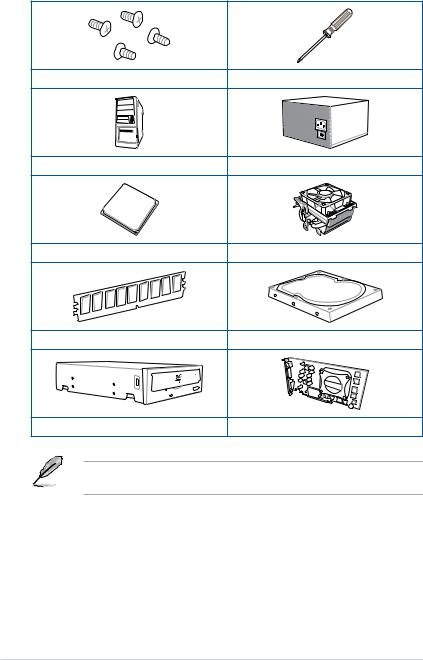
Installation tools and components
1 Bag of screws |
Phillips (cross) screwdriver |
PC chassis |
Power supply unit |
AMD AM4 CPU |
AMD AM4/AM3 compatible CPU Fan |
DDR4 DIMM |
SATA hard disk drive |
SATA optical disc drive (optional) |
Graphics card |
The tools and components in the table above are not included in the motherboard package.
xvi

Product Introduction |
1 |
1.1Motherboard overview
1.1.1Before you proceed
Take note of the following precautions before you install motherboard components or change any motherboard settings.
Components shown in this section may require additional purchase. Refer to Package contents section for more information about the contents of your motherboard package.
• Unplug the power cord from the wall socket before touching any component.
•Before handling components, use a grounded wrist strap or touch a safely grounded object or a metal object, such as the power supply case, to avoid damaging them due to static electricity.
•Hold components by the edges to avoid touching the ICs on them.
•Whenever you uninstall any component, place it on a grounded antistatic pad or in the bag that came with the component.
•Before you install or remove any component, ensure that the ATX power supply is switched off or the power cord is detached from the power supply. Failure to do so may cause severe damage to the motherboard, peripherals, or components.
Chapter 1
ROG CROSSHAIR VIII HERO (WI-FI) |
1-1 |

1.1.2Motherboard layout
1 Chapter
Refer to Internal connectors and Rear panel features section for more information.
1-2 |
Chapter 1: Product Introduction |

Layout contents |
Page |
|
|
|
|
1. |
Power connectors |
1-23 |
2. |
CPU socket |
1-4 |
3. |
DIMM slots |
1-5 |
4. |
Fan and Pump connectors |
1-21 |
5. |
Q-Code LED |
1-15 |
6. |
RGB LED connector |
1-25 |
7. |
Addressable Gen2 LED connector |
1-26 |
8. |
Power button |
1-9 |
9. |
Reset button |
1-9 |
10. |
ProbeIt |
1-29 |
11. |
USB 3.2 Gen 2 connector |
1-18 |
12. |
PCH Fan connector |
1-27 |
13. |
USB 3.2 Gen 1 connector |
1-19 |
14. |
SATA 6Gb/s connector |
1-16 |
15. |
Water Cooling System connectors |
1-22 |
16. |
System Panel connector |
1-24 |
17. |
Thermal Sensor connector |
1-22 |
18. |
Slow Mode switch |
1-11 |
19. |
USB 2.0 connector |
1-20 |
20. |
Node connector |
1-28 |
21. |
TPM connector |
1-28 |
22. |
ReTry button |
1-10 |
23. |
Safe Boot button |
1-10 |
24. |
LN2 Mode jumper |
1-12 |
25. |
Front Panel Audio connector |
1-18 |
26. |
M.2 slot |
1-17 |
27. |
Rear I/O Cover LED connector |
1-27 |
Chapter 1
ROG CROSSHAIR VIII HERO (WI-FI) |
1-3 |
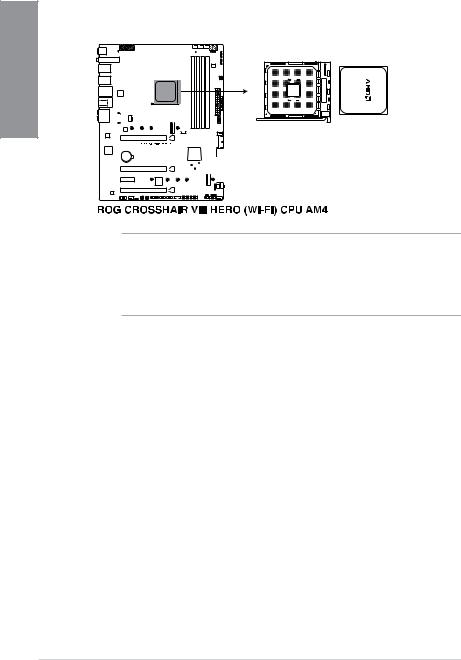
1.1.3Central Processing Unit (CPU)
The motherboard comes with an AM4 socket designed for AMD AM4 Socket for 3rd and 2nd Gen AMD Ryzen™ / 2nd and 1st Gen AMD Ryzen™ with Radeon™ Vega Graphics
Processors.
1 Chapter
•The AM4 socket has a different pinout design. Ensure that you use a CPU designed for the AM4 socket.
•The CPU fits in only one correct orientation. DO NOT force the CPU into the socket to prevent bending the connectors on the CPU and damaging the CPU.
•Ensure that all power cables are unplugged before installing the CPU.
1-4 |
Chapter 1: Product Introduction |

1.1.4System memory
The motherboard comes with Dual Inline Memory Modules (DIMM) slots designed for DDR4 (Double Data Rate 4) memory modules.
A DDR4 memory module is notched differently from a DDR, DDR2, or DDR3 module. DO NOT install a DDR, DDR2, or DDR3 memory module to the DDR4 slot.
Recommended memory configurations
Chapter 1
ROG CROSSHAIR VIII HERO (WI-FI) |
1-5 |

1 Chapter
Memory configurations
You may install 2 GB, 4 GB, 8 GB, 16 GB, and 32 GB unbuffered and non ECC DDR4 DIMMs into the DIMM sockets.
You may install varying memory sizes in Channel A and Channel B. The system maps the total size of the lower-sized channel for the dual-channel configuration. Any excess memory from the higher-sized channel is then mapped for single-channel operation.
• The default memory operation frequency is dependent on its Serial Presence Detect (SPD), which is the standard way of accessing information from a memory module. Under the default state, some memory modules for overclocking may operate at a lower frequency than the vendor-marked value.
•For system stability, use a more efficient memory cooling system to support a full memory load or overclocking condition.
•Always install the DIMMS with the same CAS Latency. For an optimum compatibility, we recommend that you install memory modules of the same version or data code (D/C) from the same vendor. Check with the vendor to get the correct memory modules.
•Visit the ASUS website for the latest QVL.
1-6 |
Chapter 1: Product Introduction |
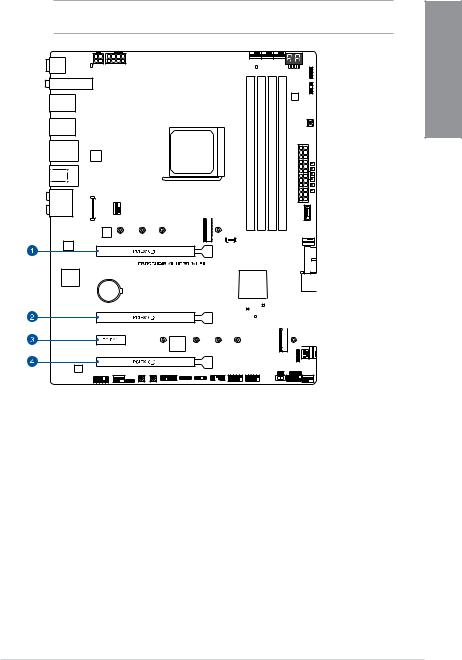
1.1.5Expansion slots
Unplug the power cord before adding or removing expansion cards. Failure to do so may cause you physical injury and damage motherboard components.
Chapter 1
Slot No. Slot Description
1PCIe x16_1
2PCIe x16_2
3PCIe x1
4PCIe x16_3
ROG CROSSHAIR VIII HERO (WI-FI) |
1-7 |

1 Chapter
PCIe operating mode
3rd Gen AMD Ryzen™ Processors
|
|
PCIe operating mode |
|
|
Slot Description |
Single VGA / |
Dual VGA / |
|
Triple VGA / |
|
PCIe card |
PCIe card |
|
PCIe card |
PCIe x16_1 |
x16 (PCIe 4.0) |
x8 (PCIe 4.0) |
|
x8 (PCIe 4.0) |
PCIe x16_2 |
N/A |
x8 (PCIe 4.0) |
|
x8 (PCIe 4.0) |
PCIe x16_3 |
N/A |
N/A |
|
x4 (PCIe 4.0) |
M.2_1 (PCIe Mode) |
x4 (PCIe 4.0) |
x4 (PCIe 4.0) |
|
x4 (PCIe 4.0) |
M.2_1 (SATA Mode) |
Support |
Support |
|
Support |
M.2_2 (PCIe Mode) |
x4 (PCIe 4.0) |
x4 (PCIe 4.0) |
|
x4 (PCIe 4.0) |
M.2_2 (SATA Mode) |
Support |
Support |
|
Support |
2nd Gen AMD Ryzen™ Processors |
|
|
|
|
|
|
|
|
|
|
|
PCIe operating mode |
|
|
Slot Description |
Single VGA / |
Dual VGA / |
|
Triple VGA / |
|
PCIe card |
PCIe card |
|
PCIe card |
PCIe x16_1 |
x16 (PCIe 3.0) |
x8 (PCIe 3.0) |
|
x8 (PCIe 3.0) |
PCIe x16_2 |
N/A |
x8 (PCIe 3.0) |
|
x8 (PCIe 3.0) |
PCIe x16_3 |
N/A |
N/A |
|
x4 (PCIe 4.0) |
M.2_1 (PCIe Mode) |
x4 (PCIe 3.0) |
x4 (PCIe 3.0) |
|
x4 (PCIe 3.0) |
M.2_1 (SATA Mode) |
Support |
Support |
|
Support |
M.2_2 (PCIe Mode) |
x4 (PCIe 4.0) |
x4 (PCIe 4.0) |
|
x4 (PCIe 4.0) |
M.2_2 (SATA Mode) |
Support |
Support |
|
Support |
2nd and 1st Gen AMD Ryzen™ with Radeon™ Vega Graphics |
|
|||
|
|
|
|
|
|
|
PCIe operating mode |
|
|
Slot Description |
Single VGA / |
Dual VGA / |
|
Triple VGA / |
|
PCIe card |
PCIe card |
|
PCIe card |
PCIe x16_1 |
x8 (PCIe 3.0) |
x8 (PCIe 3.0) |
|
N/A |
PCIe x16_2 |
N/A |
N/A |
|
N/A |
PCIe x16_3 |
N/A |
x4 (PCIe 4.0) |
|
N/A |
M.2_1 (PCIe Mode) |
x4 (PCIe 3.0) |
x4 (PCIe 3.0) |
|
x4 (PCIe 3.0) |
M.2_1 (SATA Mode) |
Support |
Support |
|
Support |
M.2_2 (PCIe Mode) |
x4 (PCIe 4.0) |
x4 (PCIe 4.0) |
|
x4 (PCIe 4.0) |
M.2_2 (SATA Mode) |
Support |
Support |
|
Support |
•We recommend that you provide sufficient power when running CrossFireX™ or SLI®
mode.
•Ensure to connect the 8-pin and 4-pin power plugs when running CrossFireX™ or SLI® mode.
•Connect a chassis fan to the chassis fan connectors when using multiple graphics cards for better thermal environment.
1-8 |
Chapter 1: Product Introduction |
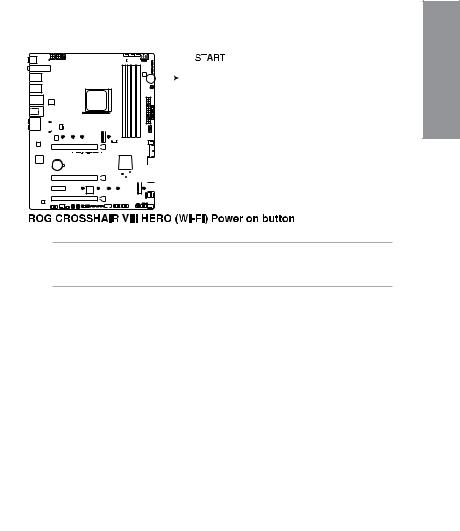
1.1.6Onboard buttons
1. |
Power button |
|
|
Press the Power button to power up the system, or put the system into sleep or soft- |
1 |
|
off mode (depending on the operating system settings). |
|
|
|
Chapter |
The button also lights up when the system is plugged to a power source, indicating that you should shut down the system and unplug the power cable before removing or installing any motherboard component.
2.Reset button
Press the Reset button to reboot the system.
|
|
|
|
|
|
|
|
|
|
|
|
|
|
|
|
|
|
|
|
|
|
|
|
|
|
|
|
|
|
|
|
|
|
|
|
|
|
|
|
|
|
|
|
|
|
|
|
|
|
|
|
|
|
|
|
|
|
|
|
|
|
|
|
|
|
|
|
|
|
|
|
|
|
|
|
|
|
|
|
|
|
|
|
|
|
|
|
|
|
|
|
|
|
|
|
|
|
|
|
|
|
|
|
|
|
|
|
|
|
|
|
|
|
|
|
|
|
|
|
|
|
|
|
|
|
|
|
|
|
|
|
|
|
|
|
|
|
|
|
|
|
|
|
|
|
|
|
|
|
|
|
|
|
|
|
|
|
|
|
|
|
|
|
|
|
|
|
|
|
|
|
|
|
|
|
|
|
|
|
|
|
|
|
|
|
|
|
|
|
|
|
|
|
|
|
|
|
|
|
|
|
|
|
|
|
|
|
|
|
|
|
|
|
|
|
|
|
|
|
|
|
|
|
|
|
|
|
|
|
|
|
|
|
|
|
|
|
|
|
|
|
|
|
|
|
|
|
|
|
|
|
|
|
|
|
|
|
|
|
|
|
|
|
|
|
|
|
|
|
|
|
|
|
|
|
|
|
|
|
|
|
|
|
|
|
|
|
|
|
|
|
|
|
|
|
|
|
|
|
|
|
|
|
|
|
|
|
|
|
|
|
|
|
|
|
|
|
|
|
|
|
|
|
|
|
|
|
|
|
|
|
|
|
|
|
|
|
|
|
|
|
|
|
|
|
|
|
|
|
|
|
|
|
|
|
|
|
|
|
|
|
|
|
|
|
|
|
|
|
|
|
|
|
|
|
|
|
|
|
|
|
|
|
|
|
|
|
|
|
|
|
|
|
|
|
|
|
|
|
|
|
|
|
|
|
|
|
|
|
|
|
|
|
|
|
|
|
|
|
|
|
|
|
|
|
|
|
|
|
|
|
|
|
|
|
|
|
|
|
|
|
|
|
|
|
|
|
|
|
|
|
|
|
|
|
|
|
|
|
|
|
|
|
|
|
|
|
|
|
|
|
|
|
|
|
|
|
|
|
|
|
|
|
|
|
|
|
|
|
|
|
|
|
|
|
|
|
|
|
|
|
|
|
|
|
|
|
|
|
|
|
|
|
|
|
|
|
|
|
|
|
|
|
|
|
|
|
|
|
|
|
|
|
|
|
|
|
|
|
|
|
|
|
|
|
|
|
|
|
|
|
|
|
|
|
|
|
|
|
|
|
|
|
|
|
|
|
|
|
|
|
|
|
|
|
|
|
|
|
|
|
|
|
|
|
|
|
|
|
|
|
|
|
|
|
|
|
|
|
|
|
|
|
|
|
|
|
|
|
|
|
|
|
|
|
|
|
|
|
|
|
|
|
|
|
|
|
|
|
|
|
|
|
|
|
|
|
|
|
|
|
|
|
|
|
|
|
|
|
|
|
|
|
|
|
|
|
|
|
|
|
|
|
|
|
|
|
|
|
|
|
|
|
|
|
|
|
|
|
|
|
|
|
|
|
|
|
|
|
|
|
|
|
|
|
|
|
|
|
|
|
|
|
|
|
|
|
|
|
|
|
|
|
|
|
|
|
|
|
|
|
|
|
|
|
|
|
|
|
|
|
|
|
|
|
|
|
|
|
|
|
|
|
|
|
|
|
|
|
|
|
|
|
|
|
|
|
|
|
|
|
|
|
|
|
|
|
|
|
|
|
|
|
|
|
|
|
|
|
|
|
|
|
|
|
|
|
|
|
|
|
|
|
|
|
|
|
|
|
|
|
|
|
|
|
|
|
|
|
|
|
|
|
|
|
|
|
|
|
|
|
|
|
|
|
|
|
|
|
|
|
|
|
|
|
|
|
|
|
ROG CROSSHAIR VIII HERO (WI-FI) |
1-9 |
||||||||||||||||||||||||||
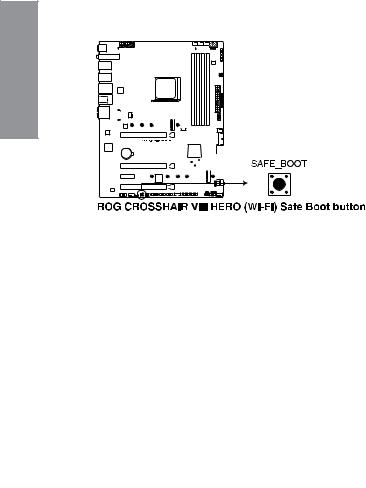
3.Safe Boot button
The Safe Boot button temporarily applies safe settings to the BIOS while retaining the overclocked settings, allowing you to modify the settings causing a boot failure. Press this button at anytime to force the system to reboot into the BIOS safe mode.
1 Chapter
4.ReTry button
The ReTry button is specially designed for overclockers and is most useful during the booting process where the Reset button is rendered useless. Press this button to force the system to reboot while retaining the same settings to be retried in quick succession to achieve a successful POST.
|
|
|
|
|
|
|
|
|
|
|
|
|
|
|
|
|
|
|
|
|
|
|
|
|
|
|
|
|
|
|
|
|
|
|
|
|
|
|
|
|
|
|
|
|
|
|
|
|
|
|
|
|
|
|
|
|
|
|
|
|
|
|
|
|
|
|
|
|
|
|
|
|
|
|
|
|
|
|
|
|
|
|
|
|
|
|
|
|
|
|
|
|
|
|
|
|
|
|
|
|
|
|
|
|
|
|
|
|
|
|
|
|
|
|
|
|
|
|
|
|
|
|
|
|
|
|
|
|
|
|
|
|
|
|
|
|
|
|
|
|
|
|
|
|
|
|
|
|
|
|
|
|
|
|
|
|
|
|
|
|
|
|
|
|
|
|
|
|
|
|
|
|
|
|
|
|
|
|
|
|
|
|
|
|
|
|
|
|
|
|
|
|
|
|
|
|
|
|
|
|
|
|
|
|
|
|
|
|
|
|
|
|
|
|
|
|
|
|
|
|
|
|
|
|
|
|
|
|
|
|
|
|
|
|
|
|
|
|
|
|
|
|
|
|
|
|
|
|
|
|
|
|
|
|
|
|
|
|
|
|
|
|
|
|
|
|
|
|
|
|
|
|
|
|
|
|
|
|
|
|
|
|
|
|
|
|
|
|
|
|
|
|
|
|
|
|
|
|
|
|
|
|
|
|
|
|
|
|
|
|
|
|
|
|
|
|
|
|
|
|
|
|
|
|
|
|
|
|
|
|
|
|
|
|
|
|
|
|
|
|
|
|
|
|
|
|
|
|
|
|
|
|
|
|
|
|
|
|
|
|
|
|
|
|
|
|
|
|
|
|
|
|
|
|
|
|
|
|
|
|
|
|
|
|
|
|
|
|
|
|
|
|
|
|
|
|
|
|
|
|
|
|
|
|
|
|
|
|
|
|
|
|
|
|
|
|
|
|
|
|
|
|
|
|
|
|
|
|
|
|
|
|
|
|
|
|
|
|
|
|
|
|
|
|
|
|
|
|
|
|
|
|
|
|
|
|
|
|
|
|
|
|
|
|
|
|
|
|
|
|
|
|
|
|
|
|
|
|
|
|
|
|
|
|
|
|
|
|
|
|
|
|
|
|
|
|
|
|
|
|
|
|
|
|
|
|
|
|
|
|
|
|
|
|
|
|
|
|
|
|
|
|
|
|
|
|
|
|
|
|
|
|
|
|
|
|
|
|
|
|
|
|
|
|
|
|
|
|
|
|
|
|
|
|
|
|
|
|
|
|
|
|
|
|
|
|
|
|
|
|
|
|
|
|
|
|
|
|
|
|
|
|
|
|
|
|
|
|
|
|
|
|
|
|
|
|
|
|
|
|
|
|
|
|
|
|
|
|
|
|
|
|
|
|
|
|
|
|
|
|
|
|
|
|
|
|
|
|
|
|
|
|
|
|
|
|
|
|
|
|
|
|
|
|
|
|
|
|
|
|
|
|
|
|
|
|
|
|
|
|
|
|
|
|
|
|
|
|
|
|
|
|
|
|
|
|
|
|
|
|
|
|
|
|
|
|
|
|
|
|
|
|
|
|
|
|
|
|
|
|
|
|
|
|
|
|
|
|
|
|
|
|
|
|
|
|
|
|
|
|
|
|
|
|
|
|
|
|
|
|
|
|
|
|
|
|
|
|
|
|
|
|
|
|
|
|
|
|
|
|
|
|
|
|
|
|
|
|
|
|
|
|
|
|
|
|
|
|
|
|
|
|
|
|
|
|
|
|
|
|
|
|
|
|
|
|
|
|
|
|
|
|
|
|
|
|
|
|
|
|
|
|
|
|
|
|
|
|
|
|
|
|
|
|
|
|
|
|
|
|
|
|
|
|
|
|
|
|
|
|
|
|
|
|
|
|
|
|
|
|
|
|
|
|
|
|
|
|
|
|
|
|
|
|
|
|
|
1-10 |
|
|
|
|
|
|
|
|
|
|
|
|
|
|
|
|
|
|
|
|
|
|
|
|
|
|
|
|
|
|
|
Chapter 1: Product Introduction |
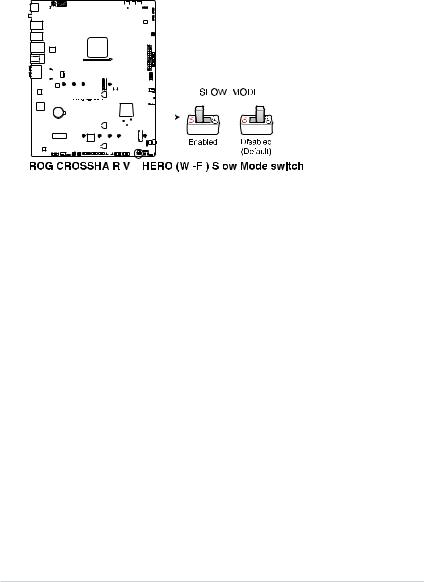
1.1.7Onboard switches
1. |
Slow Mode switch |
|
||||||||||||||||||||||||||||||
|
||||||||||||||||||||||||||||||||
|
The system may crash due to the CPU being unstable when using extreme |
1 |
||||||||||||||||||||||||||||||
|
overclocking settings. Enable the Slow Mode switch during LN2 benching to decrease |
|||||||||||||||||||||||||||||||
|
the processor frequency and stabilize the system, allowing you to keep track of the |
Chapter |
||||||||||||||||||||||||||||||
|
overclocking data. |
|||||||||||||||||||||||||||||||
|
|
|||||||||||||||||||||||||||||||
|
|
|
|
|
|
|
|
|
|
|
|
|
|
|
|
|
|
|
|
|
|
|
|
|
|
|
|
|
|
|
|
|
|
|
|
|
|
|
|
|
|
|
|
|
|
|
|
|
|
|
|
|
|
|
|
|
|
|
|
|
|
|
|
|
|
|
|
|
|
|
|
|
|
|
|
|
|
|
|
|
|
|
|
|
|
|
|
|
|
|
|
|
|
|
|
|
|
|
|
|
|
|
|
|
|
|
|
|
|
|
|
|
|
|
|
|
|
|
|
|
|
|
|
|
|
|
|
|
|
|
|
|
|
|
|
|
|
|
|
|
|
|
|
|
|
|
|
|
|
|
|
|
|
|
|
|
|
|
|
|
|
|
|
|
|
|
|
|
|
|
|
|
|
|
|
|
|
|
|
|
|
|
|
|
|
|
|
|
|
|
|
|
|
|
|
|
|
|
|
|
|
|
|
|
|
|
|
|
|
|
|
|
|
|
|
|
|
|
|
|
|
|
|
|
|
|
|
|
|
|
|
|
|
|
|
|
|
|
|
|
|
|
|
|
|
|
|
|
|
|
|
|
|
|
|
|
|
|
|
|
|
|
|
|
|
|
|
|
|
|
|
|
|
|
|
|
|
|
|
|
|
|
|
|
|
|
|
|
|
|
|
|
|
|
|
|
|
|
|
|
|
|
|
|
|
|
|
|
|
|
|
|
|
|
|
|
|
|
|
|
|
|
|
|
|
|
|
|
|
|
|
|
|
|
|
|
|
|
|
|
|
|
|
|
|
|
|
|
|
|
|
|
|
|
|
|
|
|
|
|
|
|
|
|
|
|
|
|
|
|
|
|
|
|
|
|
|
|
|
|
|
|
|
|
|
|
|
|
|
|
|
|
|
|
|
|
|
|
|
|
|
|
|
|
|
|
|
|
|
|
|
|
|
|
|
|
|
|
|
|
|
|
|
|
|
|
|
|
|
|
|
|
|
|
|
|
|
|
|
|
|
|
|
|
|
|
|
|
|
|
|
|
|
|
|
|
|
|
|
|
|
|
|
|
|
|
|
|
|
|
|
|
|
|
|
|
|
|
|
|
|
|
|
|
|
|
|
|
|
|
|
|
|
|
|
|
|
|
|
|
|
|
|
|
|
|
|
|
|
|
|
|
|
|
|
|
|
|
|
|
|
|
|
|
|
|
|
|
|
|
|
|
|
|
|
|
|
|
|
|
|
|
|
|
|
|
|
|
|
|
|
|
|
|
|
|
|
|
|
|
|
|
|
|
|
|
|
|
|
|
|
|
|
|
|
|
|
|
|
|
|
|
|
|
|
|
|
|
|
|
|
|
|
|
|
|
|
|
|
|
|
|
|
|
|
|
|
|
|
|
|
|
|
|
|
|
|
|
|
|
|
|
|
|
|
|
|
|
|
|
|
|
|
|
|
|
|
|
|
|
|
|
|
|
|
|
|
|
|
|
|
|
|
|
|
|
|
|
|
|
|
|
|
|
|
|
|
|
|
|
|
|
|
|
|
|
|
|
|
|
|
|
|
|
|
|
|
|
|
|
|
|
|
|
|
|
|
|
|
|
|
|
|
|
|
|
|
|
|
|
|
|
|
|
|
|
|
|
|
|
|
|
|
|
|
|
|
|
|
|
|
|
|
|
|
|
|
|
|
|
|
|
|
|
|
|
|
|
|
|
|
|
|
|
|
|
|
|
|
|
|
|
|
|
|
|
|
|
|
|
|
|
|
|
|
|
|
|
|
|
|
|
|
|
|
|
|
|
|
|
|
|
|
|
|
|
|
|
|
|
|
|
|
|
|
|
|
|
|
|
|
|
|
|
|
|
|
|
|
|
|
|
|
|
|
|
|
|
|
|
|
|
|
|
|
|
|
|
|
|
|
|
|
|
|
|
|
|
|
|
|
|
|
|
|
|
|
|
|
|
|
|
|
|
|
|
|
|
|
|
|
|
|
|
|
|
|
|
|
|
|
|
|
|
|
|
|
|
|
|
|
|
|
|
|
|
|
|
|
|
|
|
|
|
|
|
|
|
|
|
|
|
|
|
|
|
|
|
|
|
|
|
|
ROG CROSSHAIR VIII HERO (WI-FI) |
1-11 |
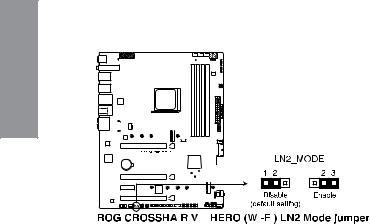
1.1.8Onboard jumpers
1. |
LN2 Mode jumper |
1 Chapter |
Set to pins 2-3 to optimize the motherboard to remedy the cold-boot bug during POST |
and help the system boot successfully. |
|
|
|
|
|
|
|
|
|
|
|
|
|
|
|
|
1-12 |
|
|
|
|
|
Chapter 1: Product Introduction |
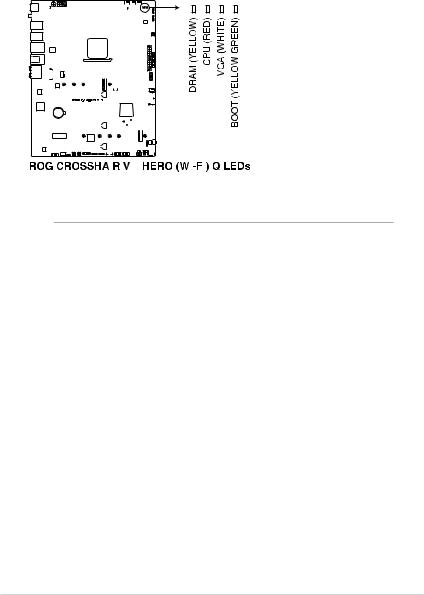
1.1.9Onboard LEDs
1. |
Q LEDs |
|
|||||||||||||||||||||||||||
|
|||||||||||||||||||||||||||||
|
The Q LEDs check key components (CPU, DRAM, VGA, and booting devices) during |
1 |
|||||||||||||||||||||||||||
|
the motherboard booting process. If an error is found, the critical component’s LED |
||||||||||||||||||||||||||||
|
stays lit up until the problem is solved. |
Chapter |
|||||||||||||||||||||||||||
|
|
|
|
|
|
|
|
|
|
|
|
|
|
|
|
|
|
|
|
|
|
|
|
|
|
|
|
|
|
|
|
|
|
|
|
|
|
|
|
|
|
|
|
|
|
|
|
|
|
|
|
|
|
|
|
|
|
|
|
|
|
|
|
|
|
|
|
|
|
|
|
|
|
|
|
|
|
|
|
|
|
|
|
|
|
|
|
|
|
|
|
|
|
|
|
|
|
|
|
|
|
|
|
|
|
|
|
|
|
|
|
|
|
|
|
|
|
|
|
|
|
|
|
|
|
|
|
|
|
|
|
|
|
|
|
|
|
|
|
|
|
|
|
|
|
|
|
|
|
|
|
|
|
|
|
|
|
|
|
|
|
|
|
|
|
|
|
|
|
|
|
|
|
|
|
|
|
|
|
|
|
|
|
|
|
|
|
|
|
|
|
|
|
|
|
|
|
|
|
|
|
|
|
|
|
|
|
|
|
|
|
|
|
|
|
|
|
|
|
|
|
|
|
|
|
|
|
|
|
|
|
|
|
|
|
|
|
|
|
|
|
|
|
|
|
|
|
|
|
|
|
|
|
|
|
|
|
|
|
|
|
|
|
|
|
|
|
|
|
|
|
|
|
|
|
|
|
|
|
|
|
|
|
|
|
|
|
|
|
|
|
|
|
|
|
|
|
|
|
|
|
|
|
|
|
|
|
|
|
|
|
|
|
|
|
|
|
|
|
|
|
|
|
|
|
|
|
|
|
|
|
|
|
|
|
|
|
|
|
|
|
|
|
|
|
|
|
|
|
|
|
|
|
|
|
|
|
|
|
|
|
|
|
|
|
|
|
|
|
|
|
|
|
|
|
|
|
|
|
|
|
|
|
|
|
|
|
|
|
|
|
|
|
|
|
|
|
|
|
|
|
|
|
|
|
|
|
|
|
|
|
|
|
|
|
|
|
|
|
|
|
|
|
|
|
|
|
|
|
|
|
|
|
|
|
|
|
|
|
|
|
|
|
|
|
|
|
|
|
|
|
|
|
|
|
|
|
|
|
|
|
|
|
|
|
|
|
|
|
|
|
|
|
|
|
|
|
|
|
|
|
|
|
|
|
|
|
|
|
|
|
|
|
|
|
|
|
|
|
|
|
|
|
|
|
|
|
|
|
|
|
|
|
|
|
|
|
|
|
|
|
|
|
|
|
|
|
|
|
|
|
|
|
|
|
|
|
|
|
|
|
|
|
|
|
|
|
|
|
|
|
|
|
|
|
|
|
|
|
|
|
|
|
|
|
|
|
|
|
|
|
|
|
|
|
|
|
|
|
|
|
|
|
|
|
|
|
|
|
|
|
|
|
|
|
|
|
|
|
|
|
|
|
|
|
|
|
|
|
|
|
|
|
|
|
|
|
|
|
|
|
|
|
|
|
|
|
|
|
|
|
|
|
|
|
|
|
|
|
|
|
|
|
|
|
|
|
|
|
|
|
|
|
|
|
|
|
|
|
|
|
|
|
|
|
|
|
|
|
|
|
|
|
|
|
|
|
|
|
|
|
|
|
|
|
|
|
|
|
|
|
|
|
|
|
|
|
|
|
|
|
|
|
|
|
|
|
|
|
|
|
|
|
|
|
|
|
|
|
|
|
|
|
|
|
|
|
|
|
|
|
|
|
|
|
|
|
|
|
|
|
|
|
|
|
|
|
|
|
|
|
|
|
|
|
|
|
|
|
|
|
|
|
|
|
|
|
|
|
|
|
|
|
|
|
|
|
|
|
|
|
|
|
|
|
|
|
|
|
|
|
|
|
|
|
|
|
|
|
|
|
|
|
|
|
|
|
|
|
|
|
|
|
|
|
|
|
|
|
|
|
|
|
|
|
|
|
|
|
|
|
|
|
|
|
|
|
|
|
|
|
|
|
|
|
|
|
|
|
|
|
|
|
|
|
|
|
|
|
|
|
|
|
|
|
|
|
|
|
|
|
|
|
|
|
|
|
|
|
|
|
|
|
|
|
|
|
|
|
|
|
|
|
|
|
|
|
|
|
|
|
|
|
|
|
|
|
|
|
|
|
|
|
|
|
|
|
|
|
|
|
|
|
|
|
|
|
|
|
|
|
|
|
|
|
|
|
|
|
|
|
|
|
|
|
|
|
|
|
|
|
|
|
|
|
|
|
|
|
|
|
|
|
|
|
|
|
|
|
|
|
|
|
|
|
|
|
|
|
|
|
|
|
|
|
|
|
|
|
The Q LEDs provide the most probable cause of an error code as a starting point for troubleshooting. The actual cause may vary from case to case.
2.CPU Status LED
The CPU Status LED will indicate the current status of your CPU. A red light indicates that the CPU is not ready to boot, and the LED will turn off once the problem is solved.
Ensure the CPU Status LED is off before powering on your system.
ROG CROSSHAIR VIII HERO (WI-FI) |
1-13 |
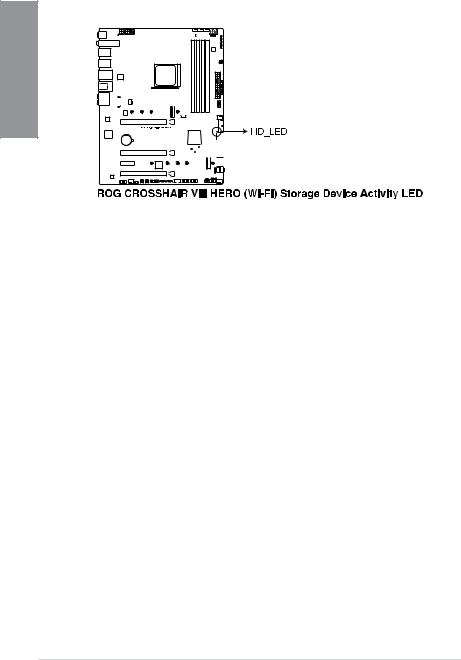
3.Storage Device Activity LED
The Storage Device Activity LED lights up or blinks when data is read from or written to the storage device or storage device add-on card.
1 Chapter
4.8-pin Power Plug LED
The 8-pin Power Plug LED lights up to indicate that the 8-pin power plug is not connected.
•DO NOT connect the 4-pin power plug only, the motherboard may overheat under heavy usage.
•Ensure to connect the 8-pin power plug, or connect both the 8-pin and 4-pin power plugs.
1-14 |
Chapter 1: Product Introduction |
